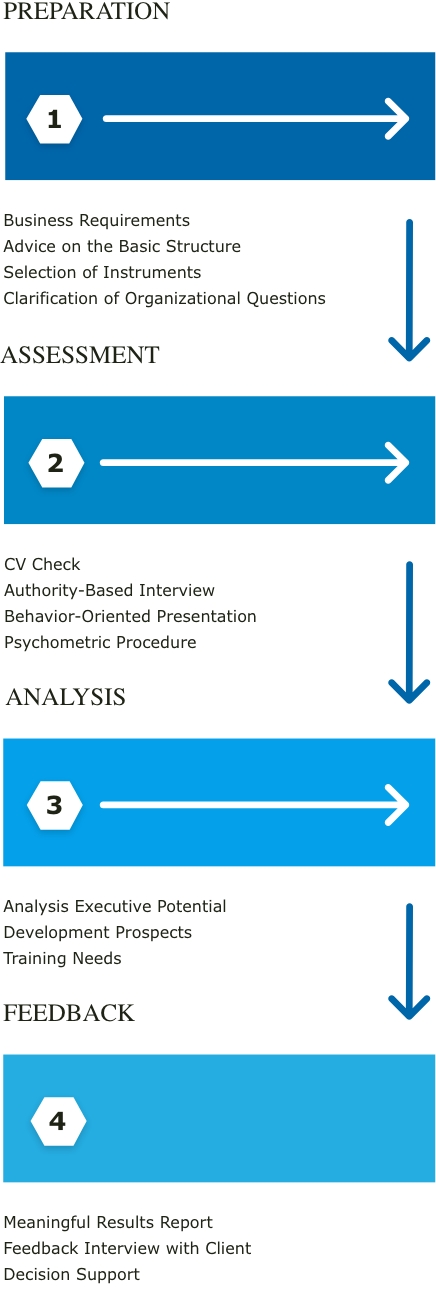Selecting employees
The Vesterling® Method
The Vesterling potential analysis for executives combines various methods and selection procedures tailored to the challenge in the company. Depending on the client’s requirements, we use interviews, behavioural presentations and psychometric procedures to ensure that the decision to fill management positions is made with the most suitable candidates.



1. Preparation
The Vesterling Executive Assessment is based on a clear basic structure and also incorporates the requirements of the commissioning company. During the consultation, it is clarified whether it should be a single potential analysis or a selection from a candidate group, which management level is addressed and which management competencies are exactly required for the position in focus. Leadership in a restructuring phase, for example, requires different skills than in a phase of expansion and product innovation. Depending on the scenario, the appropriate instruments for the executive assessment are selected and organizational questions relating to the implementation are clarified.
2. Assessment
The assessment phase begins with a CV check, with which the consultant also prepares for the potential candidate. Depending upon order and customer’s request the analysis of employee potential is carried out by two advisors. The first leads the structured, authority-based interview, the second carries out the behavior-oriented presentation. Two evaluations substantiate the psychometric procedure. Vesterling has different tests in the areas of guidance behavior, guidance styles, motivation factors and value orientation. These are selected depending upon degree of experience of the candidate to be judged and task of guidance.
Structured, competence-based interview


In the competency-based interview method for potential managers, it is important to filter out the personal characteristics, skills, interests and goals of the candidate that enable him or her to lead people. From this information, conclusions are then drawn about the “fit” between the candidate and the leadership role.
Procedure
1. Establish contact:
- Greeting
- Contact establishment
- Transition to interview
2. Self-introduction: Applicant
- Observation: behaviour, style and values
- Topics: Work experience, future expectations, etc.
- Curriculum vitae sections: older sections shorter, younger and relevant for the future leadership position in detail
- Current role(s), noteworthy projects and experiences
3. Realistic activity information:
- Information about activity, requirements and company
- Relevant technical aspects
4. Career orientation / choice of organisation:
- Questions on job-related interests
- Personal Background
- Self-assessment
5. Biography-related questions:
- Reference to the past
- Query of reality and typical behaviour
6. Competence-oriented questions:
- Motivation for the leadership role
- Critical success situation and behaviour of the candidate
- Focus on key leadership competencies for the company
7. Free conversation part:
- Situational questions from interviewer,
non-standard
8. Terminate call:
- Opportunity for candidates to ask questions
- Information on how to proceed
- Clarification of organizational questions
Interview techniques
- Biographical & episodic questions:
Concrete behavioural examples from the past are asked, starting from a situation up to the precise description of the individual behavioural actions and their subsequent effects. - Self-reflective questions:
Based on concrete experiences, the interviewee is asked to reflect on what has been said, i.e. to carry out the interpretation himself. - Systemic questions:
Systemic questions can be very helpful to encourage people to express new – and often surprising points of view in gridlocked situations. This can be achieved with hypothetical questions, circular questions and scaling questions. - Socratic dialogue:
Continued questioning about the background of a statement leads to a continual deepening of the topic and ultimately to the level of attitudes and motives.
Behavioral presentation


There is no empirical evidence that certain personality traits are associated with leadership success. Harvard University studies suggest that personal traits such as “risk-averse,” “empathetic,” “self-confident,” etc. have little impact on leadership success. Relevant, however, is the concrete, observable behavior of the executive.
Typical behaviors for successful managers
- Gaining trust and acting as a role model to build loyalty
- Promoting willingness to perform through meaningful activity and ambitious goals
- Encourage self-reliance and independent problem solving
- Offer employees individual development opportunities
- Treating employees fairly and creating justice
- Encouraging entrepreneurial thinking and action
- Creating a culture in which goals and opportunities can be transformed into results
At the client’s request, such behaviour will be examined in the course of the presentation. In consultation with the client, the task will be selected in such a way that essential competencies can be identified for the company. The candidate receives a topic, time for preparation and gives a presentation, which is evaluated and discussed immediately afterwards.
The explanation is evaluated on the basis of criteria relevant to the client. As a rule, the presentation provides clear information about personal values, the ability to reflect and the ability to communicate.
Psychometric methods


The range of processes is wide. We consider it expedient to choose the right procedure after communication with the client about the competencies to be assessed. Vesterling has questionnaires that can be used, which combine various elements of the models listed below and can be adapted to the client’s requirements. The candidate then works on the test after the presentation. A feedback interview with the candidate takes place immediately afterwards.
The consultants at Vesterling have experience with the following procedures, among others:
- Gallup StrengthsFinder
- Golden Profiler of Personality
- Assessment diagnostics of the German Bundeswehr (army)
- Personal SWOT analysis
- Types and team roles according to Meredith Belbin
- Egogram from personality and transaction analysis
- DISG personality model
- Motivation grid by Sabine Asgodom
- Self-image/foreign image comparison
3. Analysis
Vesterling consultants use the analysis of executive potential to determine the candidate’s suitability as a manager and development prospects for future management tasks. Experienced managers focus on their hierarchical development and their ability to manage complex relationships and lead many employees – even in difficult scenarios. During the evaluation, the need for further professional and personal training is recorded.
4. Feedback
The client receives feedback in the form of a meaningful written report containing an analysis of the candidate’s potential and a selection recommendation for the company. In addition to the report, the client receives verbal feedback and, if desired, support in the final decision and communication of the result to the candidate.
With the Vesterling analysis of executive potential you are in a position to make the best possible decision about future executives and consistently develop them further!

Contact
We will advise you on the Executive Assessment in a non-binding, confidential meeting.
You can reach us at +49 (89) 411114-0 or by e-mail:
